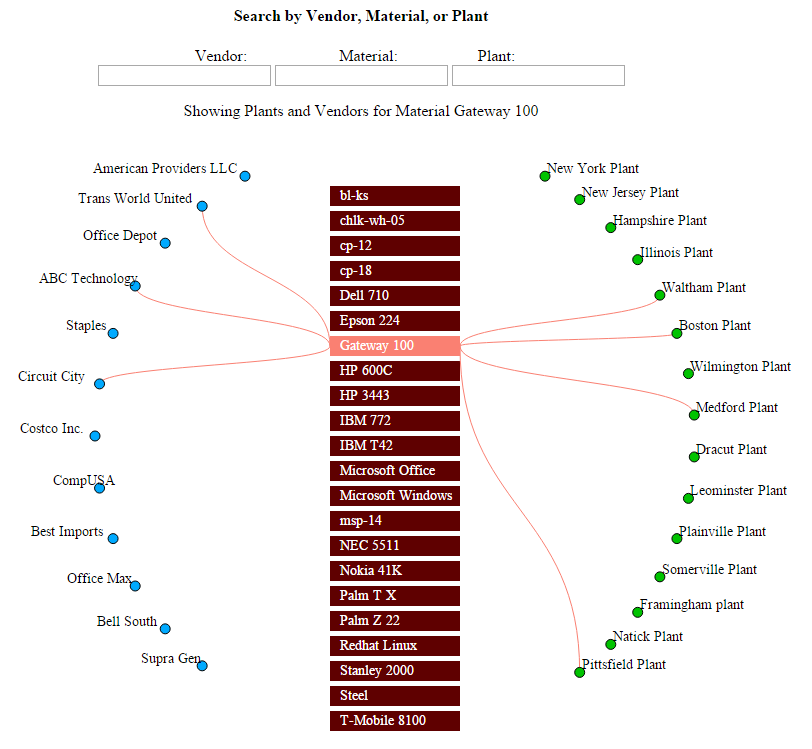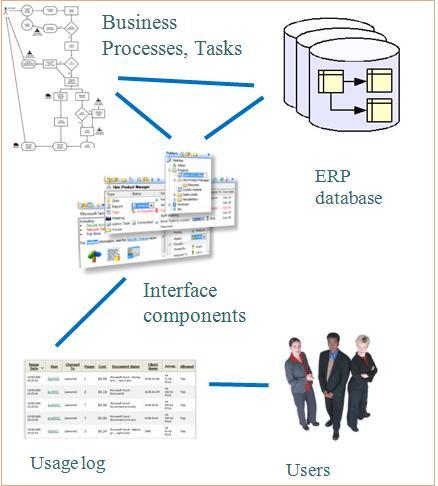ERP Viz - creating visualizations for ERP tasks


We have created two visual interactive components:
Both visualizations have been implemented and are undergoing user evaluation.



We have created two visual interactive components:
Both visualizations have been implemented and are undergoing user evaluation.
 We explore how a detailed record of system-user
interactions (a.k.a. usage log) can serve as a basis for improving system usability.
Incorporated in system design as a first-class object, log data enables a wide
variety of applications, from automated extraction of usability information to pattern
recognition to customized user support based on prior usage histories.
We explore how a detailed record of system-user
interactions (a.k.a. usage log) can serve as a basis for improving system usability.
Incorporated in system design as a first-class object, log data enables a wide
variety of applications, from automated extraction of usability information to pattern
recognition to customized user support based on prior usage histories.
To be viable for such uses in the ERP domain, the data must be easily relatable to the context of the interaction, which includes information on the task, the user, and the domain objects. We have designed a model that captures the usage data and its context, and have shown how that information can be used for discovering the realities of ERP system usage and improving ERP usability according to the design principles.
We have demonstrated the efficacy of the TIL model the feasibility and advantages of this approach in our prototype implementation.
Understanding the underlying business processes and how they are supported by the system can greatly enhance the users' ability to make the most effective use of ERP systems, yet this information is typically hidden behind opague interfaces. We have designed and implemented a prototype system that extracts and visualizes process graphs for providing task support to system users in real time. Leveraging the Task-Interface-Log (TIL) data model, this system extracts and visualizes contextual information from usage logs regarding processes and tasks supported by the system as well as the actual process instances performed by users.
We have developed design principles for improving ERP usability by aiming to create a system that acts as an intelligent partner to its user, rather than a passive tool. These principles were derived by analyzing the results of our extensive field studies of ERP usage from the perspective of system-user collaboration, informed by theory of collaborative action.
Our proof-of-concept prototypes are used to illustrate how the design principles can be implemented. While these solutions are implemented in the domain of Enterprise Resource Planning, many contributions of this stream of work, including the use of collaboration theory as a design guide, modeling and using the history of system-user interactions, have more general applicability.
Creating usable systems requires effective methods for evaluating the design of a user interface. In particular, new approaches are needed for evaluating the design of complex systems. We have developed a new usability inspection method called Collaborative Critique. Collaborative Critique is a walkthrough method based on collaboration theory. It aims to assess if the system interface acts appropriately to reduce the user's physical and cognitive effort.
We have evaluated the Collaborative Critique in a laboratory setting by comparing the CC predictions made by usability analysts with results of user testing. The results of this initial evaluation are very encouraging.
The poor usability experienced by ERP systems users may be associated with the lack of collaborative features in ERP systems. Using qualitative research methodology, we analyzed the data gathered from the field studies with employees in corporations and organizations. The results demonstrated the existence of the collaborativeness-usability relationships and we have created a conceptual model for these association relationships.
A reliable, valid survey instrument will be critical for quantitatively studying the relationship between ERP systemsí collaborativeness and usability. We have developed, validated, and tested a 34-item survey instrument to measure ERP system usersí perceptions of the collaboration between the system and the user. This instrument can also enhance our understanding of the relationships between the collaborativeness constructs and other key constructs related to information systems use, such as ease of use and usefulness.